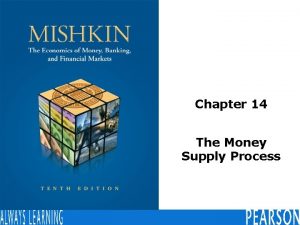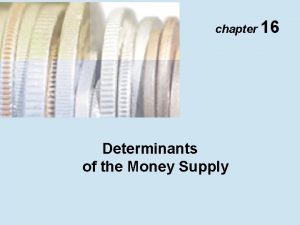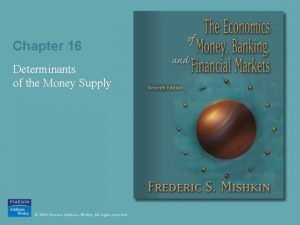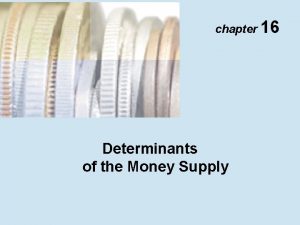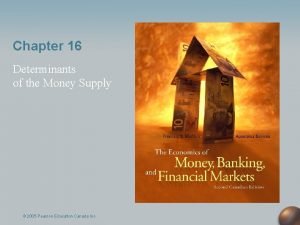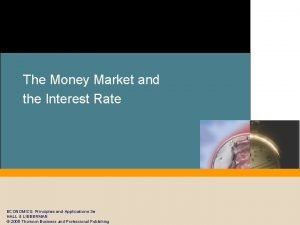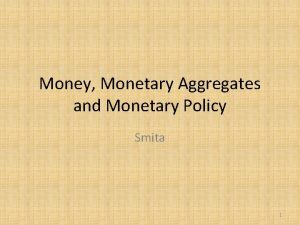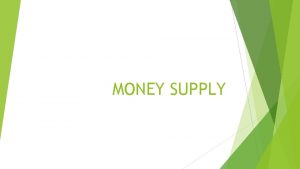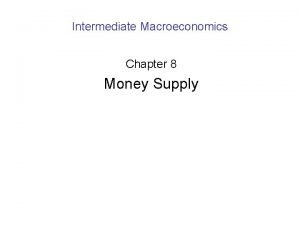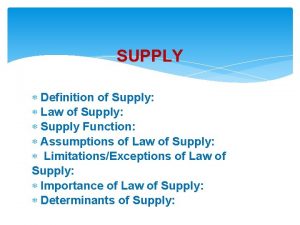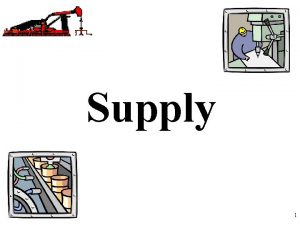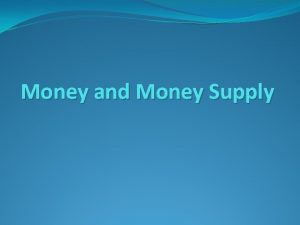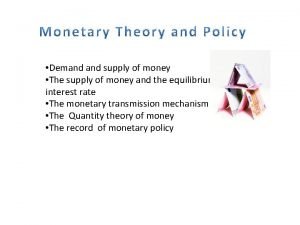Chapter 10 The Money Supply Process Money and










- Slides: 10

Chapter 10 - The Money Supply Process Money and Banking – Michael Brandl © 2017 Cengage Learning

10 -1 a Monetary Base § Monetary Base = Currency in circulation + bank reserves + U. S. Treasury currency in circulation (primarily coins) § Referred to as “high–powered money” § $1 change in the monetary base results in the money Supply increasing by much more than $1 § MB = C + R Money and Banking – Michael Brandl © 2017 Cengage Learning

10 -1 b Changes in the Monetary Base The Fed can affect the monetary base through Ø Changing banks reserve requirement Ø Open Market Operations Ø Operating the discount window Also affected by commercial banks and the cash-holding public Money and Banking – Michael Brandl © 2017 Cengage Learning

10 -2 a How the Nonbank Public Affects the Monetary Base The nonbank public can affect the monetary base in a variety of different ways. As the nonbank public changes the amount of cash it holds, the amount of currency in circulation changes. Changing the composition of the base rather than the size. Money and Banking – Michael Brandl © 2017 Cengage Learning

10 -2 b How the Treasury Affects the Monetary Base Foreign Exchange Intervention: when the Federal Reserve Bank of New York sells dollars and buys yen, the monetary base is affected. When the Fed buys the yen from a commercial bank, it deposits dollars into the bank’s account at the Fed, and bank reserves increase. Treasury Deposits at the Fed - the monetary base is affected when the federal government makes purchases or collects taxes. Treasury transfers funds between different accounts to ensure federal spending does not significantly affect the monetary base. Money and Banking – Michael Brandl © 2017 Cengage Learning

10 -2 c Deriving the Money Multiplier Changes in the monetary base have a multiple or “snowball” effect on the overall money supply Money supply = Ms. M x Monetary base Money and Banking – Michael Brandl © 2017 Cengage Learning

10 -3 a Change in Currency Ratio The currency ratio is k, which is currency/deposit Currency Ratio (K) = Currency (C) Deposits (D) Why might the currency ratio change? What is the ultimate impact of this change? Ø Level of Financial Market Development Ø Public Mistrust of Banks Money and Banking – Michael Brandl © 2017 Cengage Learning

10 -3 b Change in the Excess Reserve The excess reserves ratio (re ) is the amount of excess reserves in the banking system relative to the amount of deposits Inverse relationship between re and the money multiplier is that if banks are holding relatively more excess reserves, they are lending relatively less than before Less bank lending means less new money is being created by banks and thus a smaller money multiplier Money and Banking – Michael Brandl © 2017 Cengage Learning

10 -3 c Change in the Required Reserve Ratio The logic behind this inverse relationship between rr and the money multiplier MM= ( 1/Required Reserve Ratio) is similar to that for re: If banks are holding more reserves, they are lending out less. Less bank lending means less new money is being created and thus a smaller money multiplier. If the Required Reserve Ratio increases from 20% to 25%, the Excess Reserve would decrease. You deposit $100 in the bank. If the bank’s required reserve ratio is 20%, $20 must be keep in Reserve, allowing $80 to create new money. If the RRR increases to 25%, $25 must be keep in reserve, allowing $75. 00 to create new money. Changes in the required reserve ratio, which in the U. S. is set by the Federal Reserve, does not change often. Money and Banking – Michael Brandl © 2017 Cengage Learning

10 -3 d Money Supply Process & Quantitative Easing Under quantitative easing the Fed was buying a variety of financial assets from commercial banks. Thus banks saw their level of reserves increase, but they did not significantly increase their level of lending. As a result, the level of the banks’ excess reserves increased dramatically Money and Banking – Michael Brandl © 2017 Cengage Learning
 Dana damian
Dana damian Chapter 5 section 1 supply and the law of supply
Chapter 5 section 1 supply and the law of supply The three players in the money supply process
The three players in the money supply process The three players in the money supply process
The three players in the money supply process Chapter 16 determinants of the money supply
Chapter 16 determinants of the money supply Chapter 16 determinants of the money supply
Chapter 16 determinants of the money supply Chapter 16 determinants of the money supply
Chapter 16 determinants of the money supply Deposit multiplier
Deposit multiplier Matching supply with demand
Matching supply with demand Money market supply and demand
Money market supply and demand Money supply and credit creation
Money supply and credit creation


